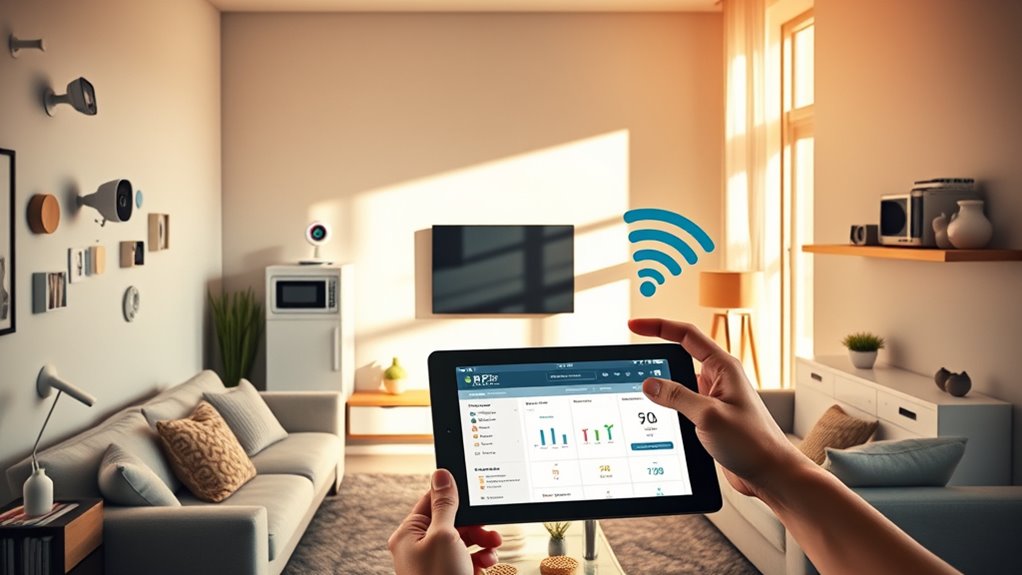To guarantee your Wi-Fi is ready for the Internet of Things, start by upgrading to the latest standards like Wi-Fi 6 or 6E for faster speeds and better device handling. Position your router centrally, use strong encryption like WPA3, and create separate networks for guests and less-trusted devices. Regular updates and high-quality hardware will boost security and reliability. Keep an eye on these tips, and you’ll be surprised how much smoother your smart home becomes.
Key Takeaways
- Upgrade to Wi-Fi 6 or Wi-Fi 6E for faster speeds, higher capacity, and improved device handling in smart home environments.
- Secure your network with WPA3 encryption and change default passwords to protect connected IoT devices.
- Position your router centrally and consider mesh systems or extenders to eliminate dead zones and ensure full coverage.
- Segment your network by creating separate guest and device-specific networks to enhance security and manage device traffic.
- Keep firmware updated regularly and invest in high-quality hardware to support the growing demands of IoT devices.

Wi-Fi has become the backbone of the Internet of Things (IoT), enabling devices to connect seamlessly and communicate in real time. If you’re integrating smart home gadgets like smart thermostats, security cameras, or voice assistants, your Wi-Fi network needs to be robust enough to handle the increased load. An outdated or weak Wi-Fi setup can cause lag, disconnections, and even security vulnerabilities, making it essential to evaluate and upgrade your network as you expand your smart home ecosystem.
A strong, secure Wi-Fi network is essential for seamless smart home device connectivity and security.
First, consider whether your current router supports the latest Wi-Fi standards, such as Wi-Fi 6 or Wi-Fi 6E. These newer standards offer faster speeds, better efficiency, and increased capacity—crucial when multiple devices are competing for bandwidth. Upgrading to a modern router can substantially improve your network’s reliability, ensuring all your IoT devices operate smoothly without dropping signals or experiencing delays. When choosing a new router, look for features like MU-MIMO technology, which allows your network to communicate with multiple devices simultaneously, reducing congestion and maintaining performance across your smart home.
Another key aspect is your network security. As you add more connected devices, each one becomes a potential entry point for cyber threats. Make sure your Wi-Fi network uses strong encryption protocols like WPA3, which offers enhanced security over older standards. Change default passwords on your router and IoT devices to prevent unauthorized access. You should also segment your network by creating a separate Wi-Fi guest network for visitors or less-trusted devices. This way, even if a device gets compromised, it won’t give hackers access to your primary network or sensitive data.
Additionally, position your router centrally in your home, away from thick walls or electronic interference, to maximize coverage. Consider adding Wi-Fi extenders or mesh Wi-Fi systems if you have a large or multi-story home, to eliminate dead zones and ensure consistent connectivity everywhere. Regular firmware updates are also crucial; they patch security flaws and improve device performance, so stay on top of those updates for your router and connected devices.
Furthermore, investing in high-quality, home theater projectors can enhance your entertainment experience, especially when paired with a strong, reliable Wi-Fi network to stream content seamlessly. Ultimately, ensuring your Wi-Fi network is ready for the IoT involves a combination of hardware upgrades, security practices, and strategic placement. Your smart home devices rely on a stable, secure connection to function flawlessly, so taking these steps enhances both your convenience and your network’s resilience. By investing in a capable router and safeguarding your network security, you’ll create a foundation that supports your growing smart home ecosystem and keeps your connected devices running smoothly.
Frequently Asked Questions
How Do I Identify Compatible Iot Devices for My Wi-Fi Network?
To identify compatible IoT devices for your Wi-Fi network, start by checking the device’s specifications for device compatibility and network integration. Look for devices that support your router’s Wi-Fi standards, like 802.11ac or ax. Read product descriptions and reviews to verify they connect easily to your existing network. Confirm they use common protocols such as Wi-Fi, Zigbee, or Z-Wave, which ensure seamless integration and reliable operation.
What Security Measures Should I Implement for Iot Devices?
You should implement robust security measures for your IoT devices. Start by enabling device authentication to guarantee only trusted devices connect. Also, set up network segmentation to isolate IoT devices from your main network, reducing potential threats. Regularly update device firmware, disable unnecessary services, and monitor network activity for suspicious behavior. These steps help protect your network and keep your IoT environment secure.
How Can I Improve Wi-Fi Coverage for Multiple Iot Devices?
Think of your Wi-Fi as a garden needing a thriving root system. To improve coverage for multiple IoT devices, you can plant mesh networks across your home, creating a seamless web of connectivity. Signal boosters act like fertilizers, strengthening weak spots. Together, these tools guarantee your devices stay connected, no matter where they’re placed, giving your smart home the healthy, reliable network it needs to flourish.
Are There Specific Wi-Fi Standards Better Suited for Iot?
You should look into Wi-Fi 6, as it’s designed for better performance with multiple devices. It supports higher speeds and improved efficiency, making it ideal for IoT. Mesh networks also enhance coverage and reliability, ensuring your devices stay connected. By upgrading to Wi-Fi 6 and setting up a mesh network, you’ll create a robust environment that handles numerous IoT devices seamlessly, keeping your smart home running smoothly.
How Often Should I Update My Wi-Fi Firmware for Iot Security?
Think of your Wi-Fi as a fortress guarding your smart devices. To keep it strong, you should perform firmware maintenance regularly, ideally once a month. This includes applying security patches promptly to patch vulnerabilities. Regular updates are like reinforcing your fortress walls, ensuring your IoT devices stay protected from cyber threats. Staying vigilant with firmware updates keeps your network secure and ready for the expanding world of IoT.
Conclusion
Now’s the time to upgrade your Wi-Fi for the Internet of Things—because by 2025, over 75 billion devices will be connected. With so many gadgets sharing your network, a reliable, secure Wi-Fi setup is essential. Don’t wait until your devices lag or get hacked; take action now. Upgrading your Wi-Fi not only boosts performance but also keeps your smart home safe. Make sure you’re ready for the connected future—your devices will thank you.









